
 |
Italy in figures |
| Italian translation |
By Stefania Fidanza and Daniela Eutizi, ITALY,
1997
(English translation from the Italian original by
Barbara Buddeke of Accademia
Farnese, Caprarola (VT), ITALY)
Contribution to the
EDUVINET "Living
Conditions of EU Citizen" subject
The Italian actual population amounted in December 1996 to 57,456,000 million of inhabitants. Of them 15,1% (1995) is represented from young people under 20 years; 68% from the population between the 20 and the 64 years; 16,4% (1995) from people of 64 and more. The active popolation is constituted from 20 millions of inhabitants. The pensioners are 18% of the population ; the students at the University are 1.656.413.
The first table shows the pyramid of age in Italy and in Europa. You can deduce that the population, in Italy like in all the European Comunity is getting old. In fact while the Italian population from 0 to 20 years amounts at 28 %, that from the 60 and up sixty is around the 20%. Is rather substantial the population between the 30 and the 50 years, 30% , that corresponds to the births happened to the epoch of economic boom in the years '50-'60.
 |
 |
In the second table you can see the natural movement of the population in the years 1994-1997. At Novembre 1996 the population was slightly increased as regards December of 1996 (57.456.000 against 53.333.000). The marriages however decreased from the 269,520 of 1994 at 257,453 at Nov. 1996.There was an increase of around 10,000 of natives alive but there was also an increase of the corpses. Italy has a rate of natives of 1,19 child pro family, a rate between the lowest of the world.
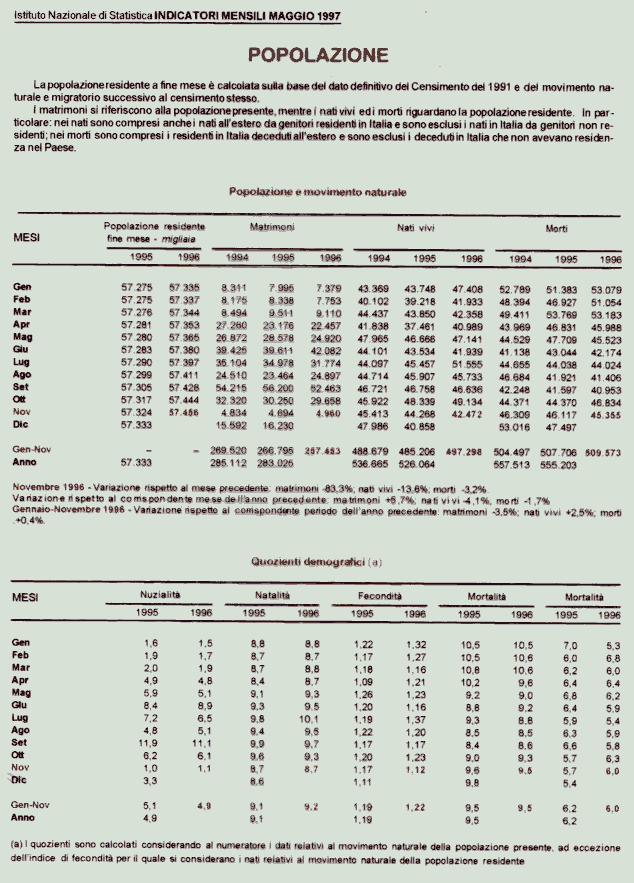
The increase of the population is also due to the immigration movement from Africa, from Asia and from Europe of the East. From the last part in fact the immigration was rather substantial. If currently Italy is destination of immigrated from the South of the world, she stayed in the course of her history, also recently, earth of emigrants. The maximum peak of this phenomenon was touched in the years between the 1896 and the 1914 with 8,000,000 of expatriated towards the European countries, southern America and the USA. But also in the following years there was a movement of emigration.
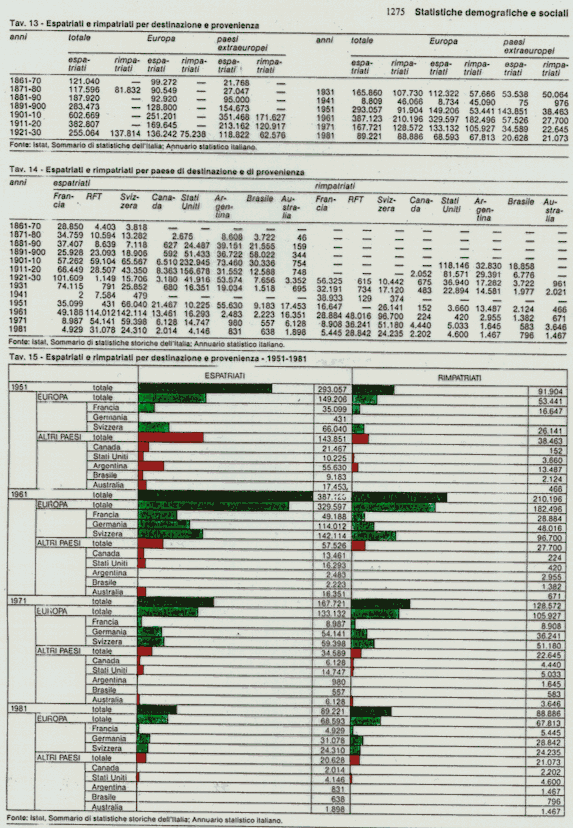
You can notice on the chart of the historical migration between the 1869-70 and 1915 that the migratory flow passed from the 0.5% of 1870 (110.000 people) at 2.5% of 1915 (900.000 people).
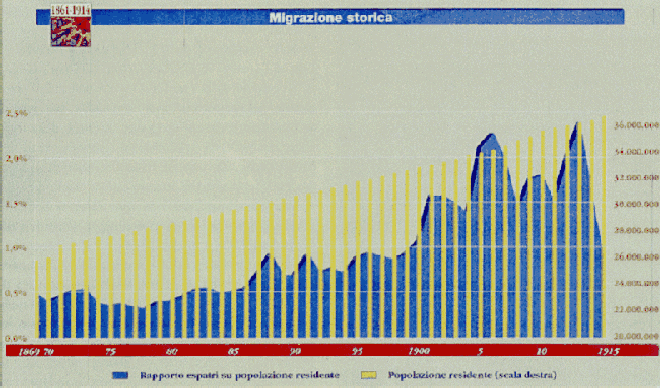
Italy results to be from the moment of her birth a country with more marches: in fact while in the North (Piedmont, Lombardy, Liguria) developed an embryonic industry that gravitates on the foreign markets (French, Swiss, German), the center possesses a certain organization of banking, commercial and handicraft system, the South is that with greater problems. In fact the agricultural enterprise in the South, that is the principal font of income, is structured in big ÔlatifondiÕ cultivated extensively and there are present only two industrial nucleuses, one Swiss, to Salerno, and one, that needs government interventions, at Napels.
In each case the agriculture occupied the 70 % of the population, the industry 18% and the tertiary 12% (data 1861); In the period between the 1896 and the 1908 the incidence on the PIL (Gros Domestic Product) of the agriculture was of 43% and in the 1911 the employees to the agriculture are 55.5% of the active population, that of the industry 26% .
Now we will have a look at the growth of the private PIL in the years 1861-1914: the growth was rather slow (1,3% annual). The agriculture passes from 58 % at 43 %. The industry passes from less than 20% at 26 %, the services from 20% to beyond the 30% .
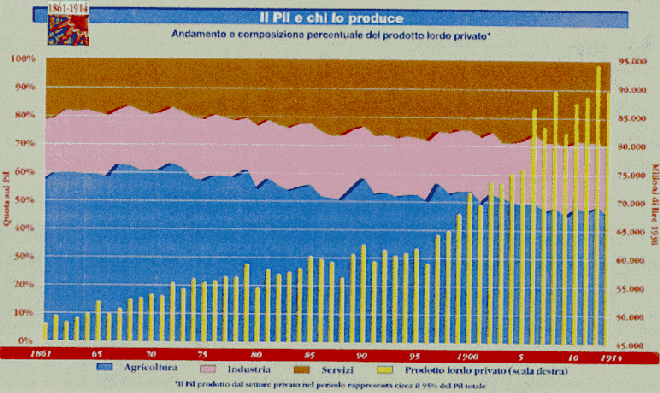
Course and composition of the investments (1861-1914): The dynamics of the investments has an annual growth of 2.8% with a strong release at the end of the period, in fact between the 1905 and the 1914 the expenses double, probably because of the industrial take-off. Decreased instead notably the expenses for the pubblic work sector.
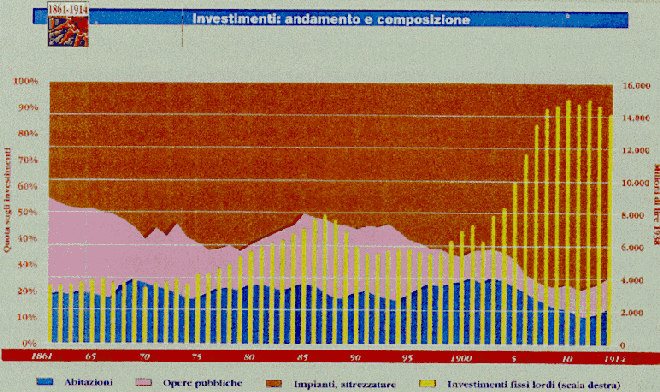
The next table shows industrial products: sugar and steel. Both departs in 1861 from 0 and they have a rate of elevated growth: 26.5% annual for the sugar and 18.2% annual for the steel. The first is tied up to the introduction of the beet; the second according to the development of the railway.
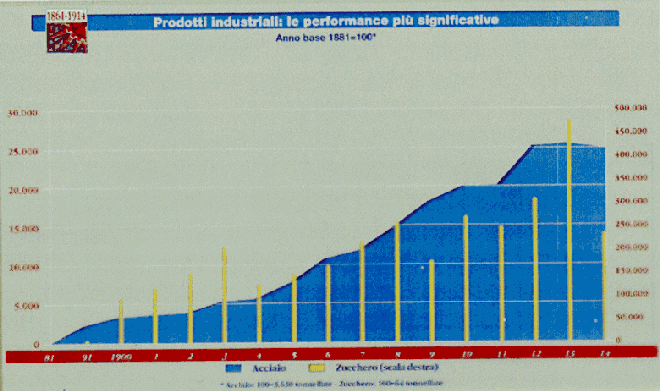
The agricultural products: wheat, potatoes, beets from sugar. After 30-40 years of stagnation, the production begins to grow towards the end of the century. The surrenders of the wheat grow from the 0.4% at 5.8% , the production of potatoes grows from the 2.1% at 4.3 %; the production of the beet though suffering a deceleration is however attested to 10% .
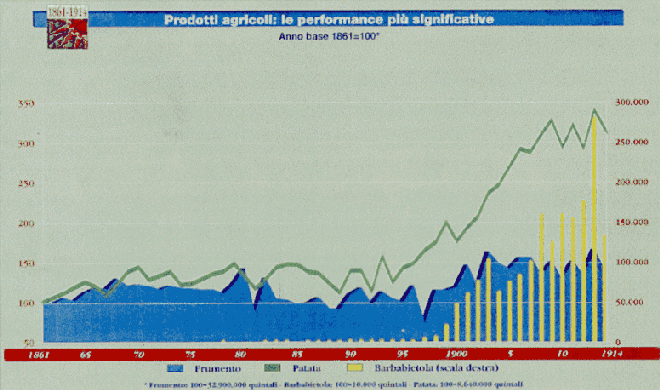
The fifth table indicates the course and compositions of the consumptions. (1861-1914) The consumptions grow with an only annual average of 1%
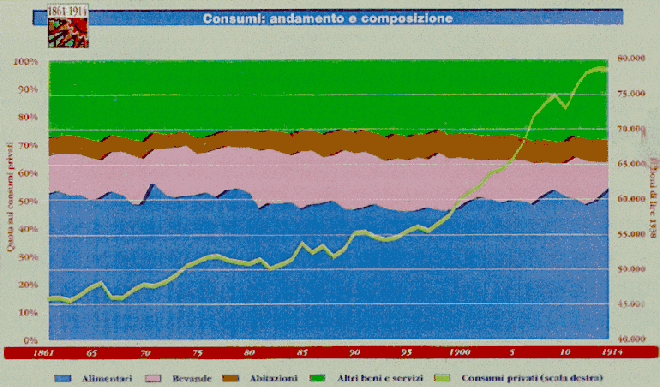
Expenses of the Italian State years 1946-1969. The change of the society and the change of the production system cause modification necessarily also of the public expenses. They spend in fact from the 12.7% of the 1946 to almost 20% of the 1969. These are the years of the economic Boom, the State gets organized. The State reduced the acquisition of goods and services but they increased the transfers, sign of the beginning of the welfare state.
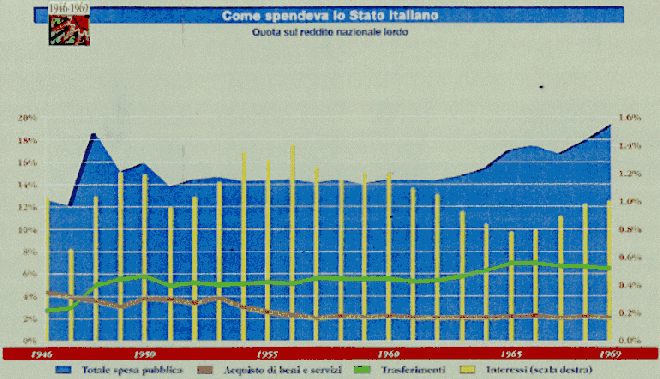
Table 7. Despite the big economic and social development Italy continuous to be a country rather unbalanced to the own inside. The industry attested is above all in the North and in the Roman area while the South, which has had a process of industrialization in the years '70 and '80, has not been able to decapitate. As regards this situation there are two essentially problems: the first is tied up to a plan of development completely subdued to 'clientelari' affair that has prone to the birth of" cathedrals in the desert" often released from the economic national and international processes: meaningful is in this sense the case of Gioia Tauro, an establishment of production of steel, cost many millions and entered never in function for the crisis of the steel. Currently Gioia Tauro became one of the most important Italian harbors for the commerce with the extreme east, but is strongly penalized from the lack of infrastructures and the lack of adequate streets of communication. The same problem is denounced with strength in the North East of the Country where the small and average industry loses big casualties tied to the problems of transport of the goods. The table, that brings information of 1992, makes evident the structural discrepancies from Italy: in fact, while the North West, part of the Center and the region from Rome has more infrastructures than the national average, the South and the Islands present situations of absolute lack. In white on the table you can find areas with a recent industrial development and an inadequacy of infra-structures according to the economical needs.
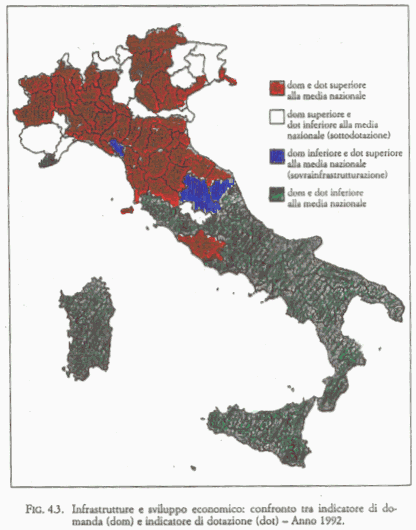
c. employment and unemployment
Table 1. Course of the occupation for sectors of employment (aa.1951-69).
In the 1951 best part of the working people was still employed to the
agricultural sector, in the course of the considered period is been present the
progressive diminution to advantage of the industry and of the services but the
sector that has had the best increase, was certainly that of the public
administrations. There was the myth of the fixed place in the State and in the
'semi-state' that, fed from a 'clientela' political, brings to the boom of the
sector in the years '70, when the sector is made to feel a certain economic
recession due to the energetic crisis and to the international monetary
turbulences.
Currently the situation of the occupation in the State and in
the 'semi-state' (ENI, IRI, IMI, INA.) is in decrease above all for reasons of
budget and changes in the economic politics of the Italian State.Interesting to
notice how the excessive development of the expenses for wages of pubblic
dependents has stopped the productive investments in many sectors. A case
macroscopic is represented from the public education where beyond the 90% of the
budget is represented from the retributive expenses.

The second table shows the employed and the unemployed person for region.
On
the left side you can see the occupational situation from Lombardy with almost
4,000,000 of attache for the varied sectors; on the right side you can notice
the situation of the Calabria (almost 24% of jobless on the active population),
and of the Meridione generally (Campania, Basilicata and Islands)
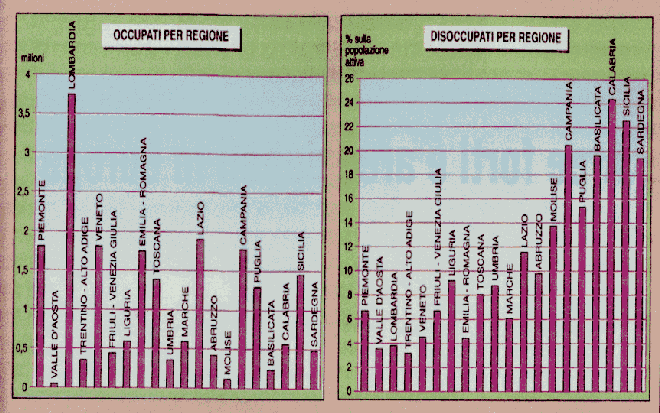
Table three shows the regional situation of the unemployment in the 1995.
Is underlined in the North West the situation of the Liguria with a rate
of 11,7% worrisome the juvenile unemployment that represents 41,1%. The
situation of Liguria, rather distant from that of the others regions of the
area, is essentially caused by changes in the area: the big productive
assembles (like IRI) in the region from Genoa is having an important
reorganizating and the private local entrepreneurs were not able to answer with
new industrialization or reconversion of the fittings. A similar problem but
not as big as in Liguria, we can see in Piedmont with 8,4% of the unemployment
due to the process of the restructuring of the FIAT.
In the North-East is
to underline the situation of the Friuli Venizia Gulia with 7.6% of
unemployment. This is connected to varied factors: the crisis of the harbor of
Trieste, that however is in recovery, and to the proximity with the ex
Jugoslavia.
In the Centre is the region Lazio, the region with the most
jobless (12,7%) caused from the crisis of the small and average enterprise and
from the block of changes in the public sector.
The situation of the South
(Mezzogiorno), is already underlined in the preceding table, it shows the
tragicalness of the problem above all because the unemployment is mainly the
juvenile one and that of long duration.
The long duration of the
unemployment depends mainly from the fact that areas once productive like
Bagnoli disappeared.
About the young unemployed people, we can
distinguish two important groups:
a) unemployment of qualified young
people (diploma recipient and graduates) deriving from the middle class and from
the proletariat that see in the education a real possibility of social ascent or
a "parking " waiting for a job;
b) unemployment of young
people who are not qualified, generally represented from young people
deriving
from the lowest classes of the population, thick illiterate or almost that, and
for the serious economic recession that interests all the area, they don't have
even the possibility of being engaged like apprentices in small firms.
An
appearance that goes however denounced and on which there exists only general
estimates, is that of the black job, where they often use young people in
conditions of slaves (20.000 £ to the day for 15 hours of job).
Important
to tell that not only in the Meridione there are big knapsacks of manpower not
qualified. In fact a macroscopic case is presented from the North East of the
Country where, paradoxically, quite the big presence of jobs gives birth to a
low schooling of the population (the young people stay generally to the
obligation= 14 years). This, in the along term, could reveal itself a phenomenon
of certain economic recession of the area.
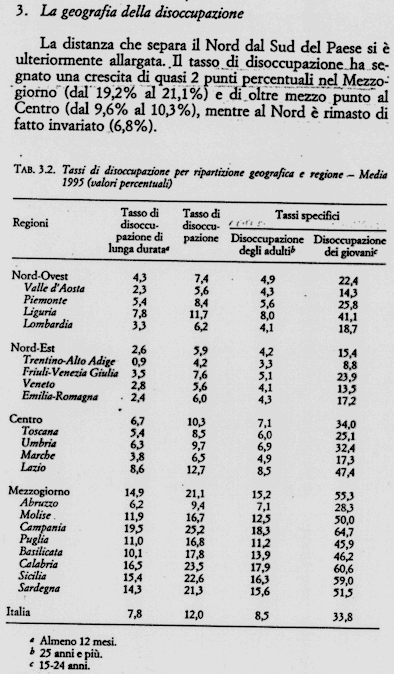
Table 4 individualizes the workers employed for sector and the dimensions of the enterprise. The most important appearance is constituted from the dimensions of the enterprise. In fact in Italy, otherwise from the rest from Europe, prevails the dwarfish (162.273 firms) and average enterprise (32.883 firms), while the industry with beyond 500 employees is constituted only from 16,212 firms.

The fifth table represents the distribution of the employment in graphically base to the dimensions of the enterprise comparing it with the situation of other European countries. You have to know that in Italy the dwarfish enterprise occupies 59% of the busy, against 19% from Germany and Great Britain; and that in Italy only 19% of the employed people are working in firms of big dimensions against the 52% from Germany and the 47% of the Gran Bretagna.
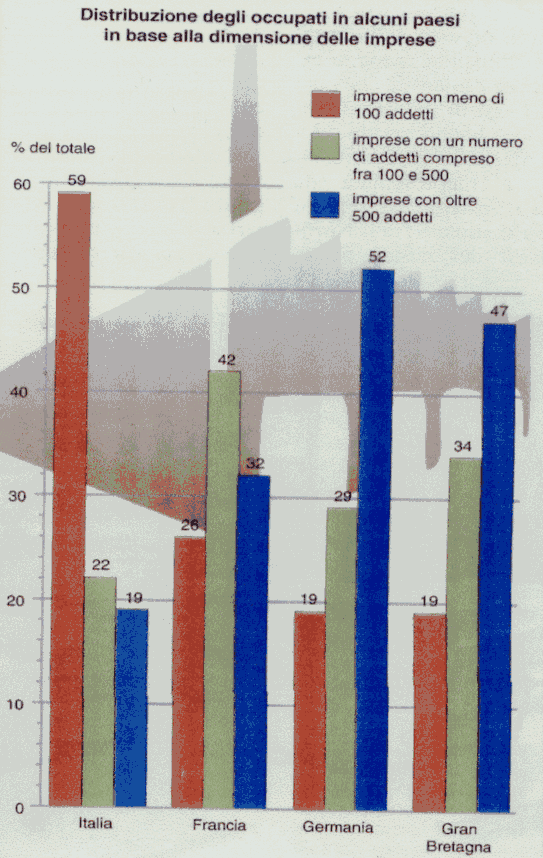
The following table shows the situation employment/unemployment according to
title of study: comparing the data of the 1978 with those of the 1994. In 1978
the highest percentage of employed workers (ca.60%) possessed as title of study
the elementary school or no title.This is explained by the fact that it
considered elderly workers and employed young people in the agriculture or in
the building.
The percentage of dismissed from the middle school (the
school of obligation) employed was around the half as regards to the workers
without title of study; the people employed with a diplome were less than 20%
and the graduate less than 10%.
Like the data already analyzed, also the
percentage of the unemployed persons had an analogous movement to the precedent
with an obvious reduction of the rate between the deprived of title (30%);
between the dismissed from the middle school (38%), between the diploma
recipient (28%) and less between the graduated(10%).
The growth of the
tertiary sector and better schooling has prone a notable change in the
occupational structure in the 1994.
In fact, there has been an increase of
the busy graduates and diploma recipient and those in possession of the license
of the obligation while have been reduced to 1/ 3 those with the elementary
license or without title. And while stayed almost unchanged the number of the
unemployed person furnished of title of study, increased the number of
unemployed persons dismissed from the school of obbligation.

Table 7. Contracts of Job Formation. These contracts, of the duration of two
years, came enacted from a law of the 1984 to make front to the problem of the
juvenile unemployment (workers interest in fact are under of 30 years) and to
make front to the reorganization of industry.
They have two big limits: the
first is represented from the low limit of age required being engaged; the
second depends on the fact that the industry, paying lower burdens often donÕt
confirm the assumption to indefinite time of the workers engaged with contract
of formation, so that they can continue to enjoy of the economic benefits
offering new contracts of formation to other workers.
You can notice that
the most active in the presentation of the plans and in the assumptions, are
the Veneto and Lombardy, the regions with the strongest economy.
A social
sore for which there doesn't exist reliable information, is the presence of
'black' job , diffused in almost all Italy.
A interesting phenomenon is
instead constituted from the voluntary job that in these years has grown
notably . The phenomenon is diffused above all to the North and is present above
all in the partner-relief and sanitary sectors, sectors where the State fails.
Meaningful
to my judgment is the scarce presence of associations of archaeological and
environmental guardianship in an extremely rich 'cultural' country. This
underlines further the scarce cultural attention that in these years is being
turned to this sector.
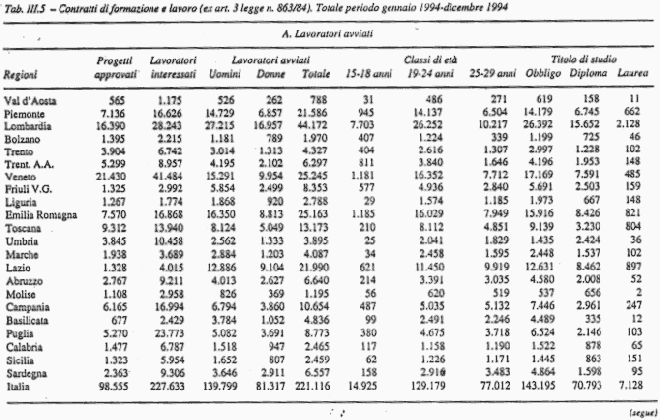
The scholastic system currently in operation in Italy is probably destined to last only other few years, in as the actual minister of the public education has presented a proposal of reform.
Currently the scholastic formation is divided in two parts:
Close to this system, financed from the State and dependent from the Office of the public education, exists also a regional system of vocational training.
Table 1. The dispersion scholastic is tall above all between the males and touched points of almost the 40% in the first year of the professional schools. Is rather low in the classical and scientific high school, but this makes sense considering the cultural background of whoever approaches at the two types of school.

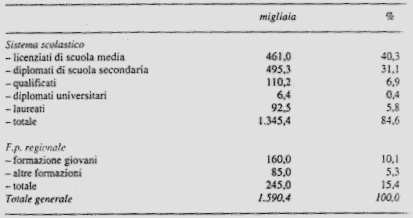
Comparing Italy with the with the other European Countries, the rate of Italian graduates results in the norm. Important to keep in mind however the following:
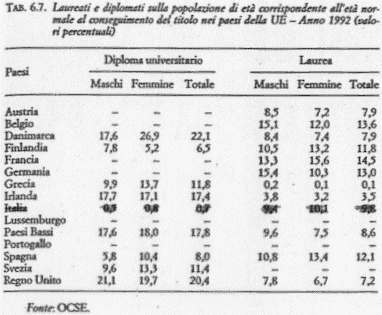
The fourth table presents the regional expense for the Professional Training
in the years 1991-1994. You can see that she has reached the highest point in
1993 and that in the 1994 she was lower than in 1991. Not all the regions,
however, have decreased their appointment like the Campania (74,2%), Lazio
(64%), Molise (62,9%), others like Basilicata , Emilia and Veneto continue
however to invest.
It goes noticed also that, in each case, the strongest
collision happens in the regions of the South, while the less substantial one is
in the Center.
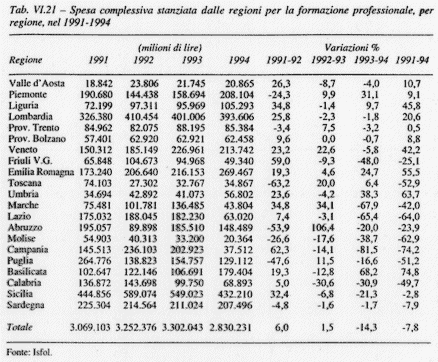
Table 1. Comparising between Italian Welfare and European.
The Italian
Welfare Italian is rather unbalanced in favor of the pensions. The expenses for
the pensions absorbed 15.1% in the 1995 of the PIL (Gros Domestic Product)
(13,74 in the 1994) against the 13.5% from Germany, and 11,9% of the European
average, while from that what stayed of the 25.8% of the PIL appropriated for
the social expense in the 1992, only 5.4% was destinated for the health
against the 6,5% of the European mediate and only 3.7% to other needs as the
politics for the occupation, the unemployment, the family, the house in front
of average 8.8% from all European countries.
All that is owed to a series
of errors of evaluation that carried in the 1965 to the creation of the pensions
of seniority (35 years of contributions); in 1968 with the Boldrini they changed
the pension system from contributions (pensions in base to the payments
effected) to a system of retributions (pensions in base to the mediates of the
salaries) ; in the 1973 they defined a special system for the government
dependent in which they could go retired with 20 years of service for the men
and with 15 years, 6 months and a day for the married women; and last but not
least in 1969 they created the system of the social pensions for those citizens
deprived from income. The unbalance of the pensions between Italy and UE
countries is visible also on the clean salary average between Italian workers
and the European workers.
The pensions have stayed an useful tool to the
industry also, in fact in the 1994 for example they gave pensione to 50,000
workers of the railroads, to 17,000 in the steel and iron firms, in this way
they were able to restructure freeing themselves of the oldest and most
expensive manpower. The burdens of this operation are in fact also other
expensives for the State.
The workers dismissed from firms with more than
15 dependent is therefore excluded. The dwarfish enterprise that represents an
element however important in the Italian structure have right to the CIG, (Box
Integration Earnings) that can be ordinary or special (in case of restructuring
of the firms). This integration is around 80% of the normal salary and it
comes paid with a bottom supported from the enterprises. (Tav.2 CIG Chart))
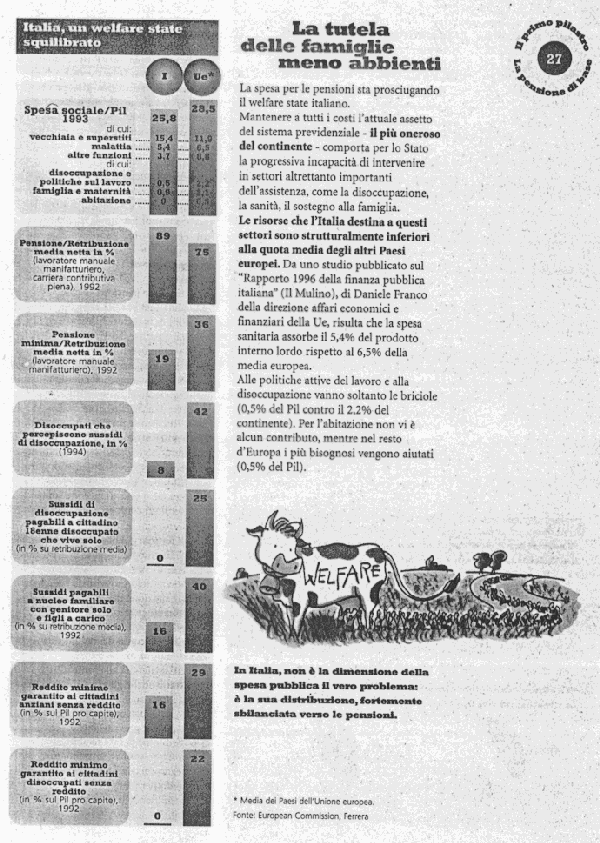
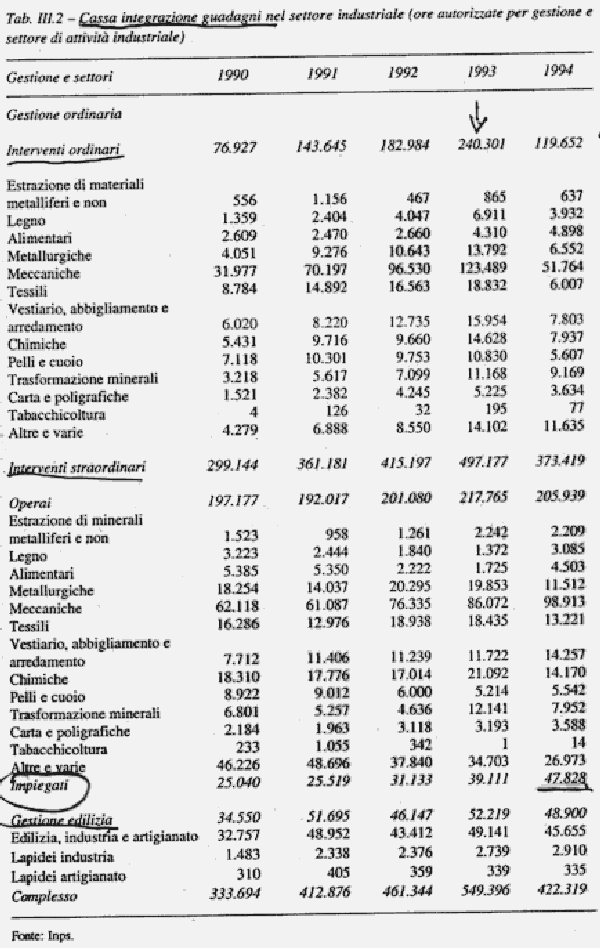
If the firm with more than 50 dependent closes or however if after the restructuring of the firm the worker is not been taken anymore, he comes affiliate to the lists of mobility and receives the salary for a year, in proportion to the age, from the State. (Tav.3 Lists of mobility)
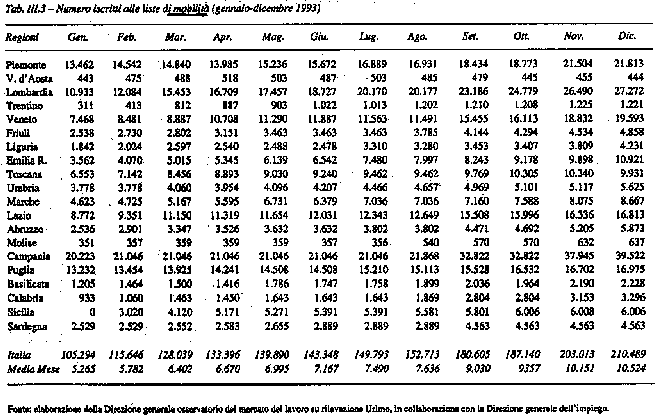
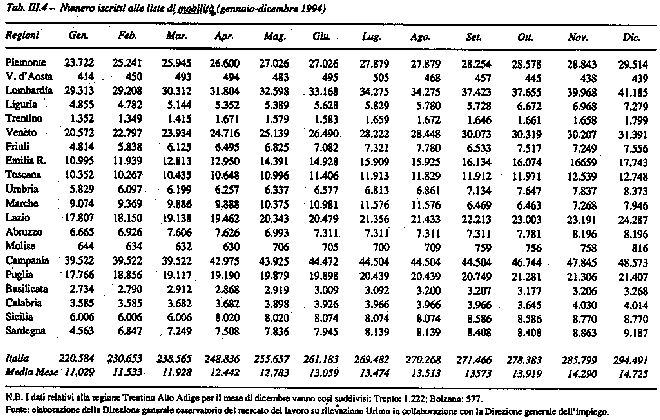
Also the invalid citizens have rights to help from the State that can be or
a pension of invalidity disbursed from the INAIL (Institute National accidents
on the job); this pension is only for those people that have contracted the
invalidity on the job; or the pensions come from the INPS (that pay also the
pensions for the private dependent and for the elderly without income.) and for
those people that are affected from illness from the birth. Important to
remember that one of the most serious and recent scandals in Italy is that of
the false invalidity.
The pensions of invalidity are past from the
7,813,452 of the 1980 to the 7,187,194 of the 1994 and their middle amount is
climbed in the same period from 6,300,000 annual to 8.000.000.
What about
the helps to the unemployed person, only 8% has right on it (in Europe 42%) and
the young people in search of occupation doesn't perceive any help from the
state (in Eu they get in general 25 % instead of the middle salary) and that the
jobless citizens without income are subjects to the same treatment (while in
Europe they receive in general 22% of the PIL (Gros Domestic product) Social
pension; the elderly citizens without income received around the 16% of the PIL
(in Europe the 29%) .
It is immediately clearly that the first knot to
loosen for resolve the problem of the excess of weight of the pensions is that
of separate Foresight ( pension expenses) and Assistance (social expenses) that
in this moment represent one only voice and that somehow has been managed
together.
Summarizing table of the social and economic course from Italy in the 1996.
The incidence of the poverty in the 1996 is in light decrease respect to the
preceding year but is increased more respect at 1994. The poverty concerns
the boys up to 18 years and the people with more than 60 years and is attested
mainly to the South. The uneasiness juvenile is very strong for the absence of
job and are very numerous the young people that live in family up to the age of
30 years and this involves also a certain reduction of the marriages (2,8%) .
Also
the nativity is in decrease because of a diminution of the optimism in the
future also for structural reasons (shortage from childcare facilities,
organization of the job.). Increased also the foreign juvenile delinquency
(gypsies and immigrated clandestine) connected above all to the sale of drugs
and to the prostitution (+60%) .
The income is increased but in accordance
didn't increase the power of acquisition of the coin and also decreases the
propensity to the saving that probably answers be to an emotional factor (it
doesn't have sense to spare if the perspective of collisions is not seen) and
also an economic factor.
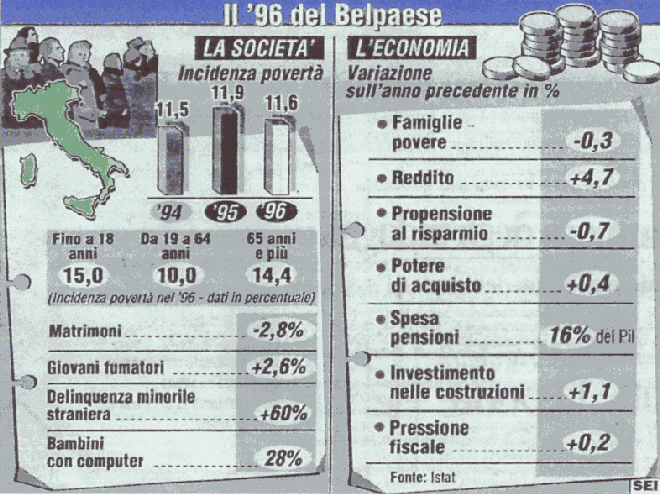
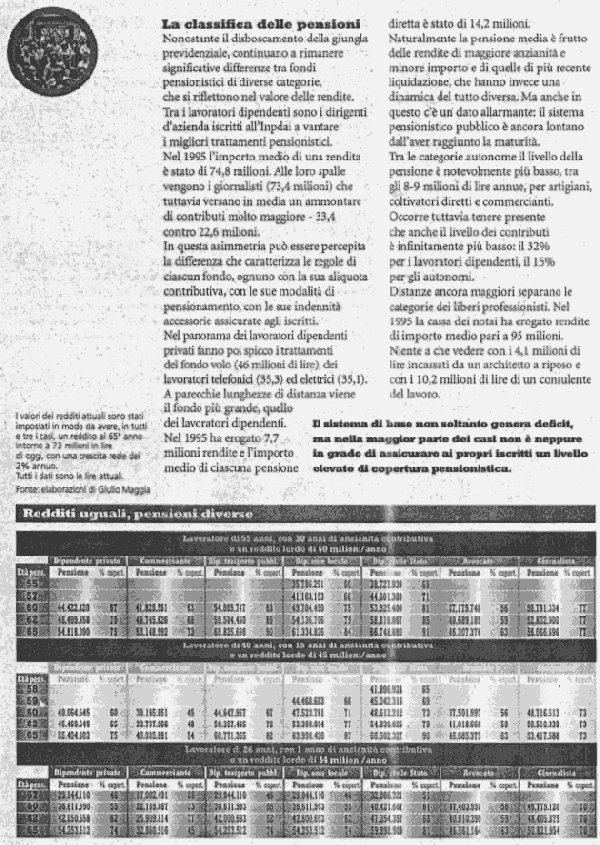

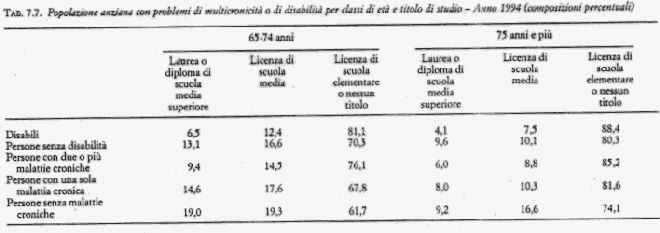
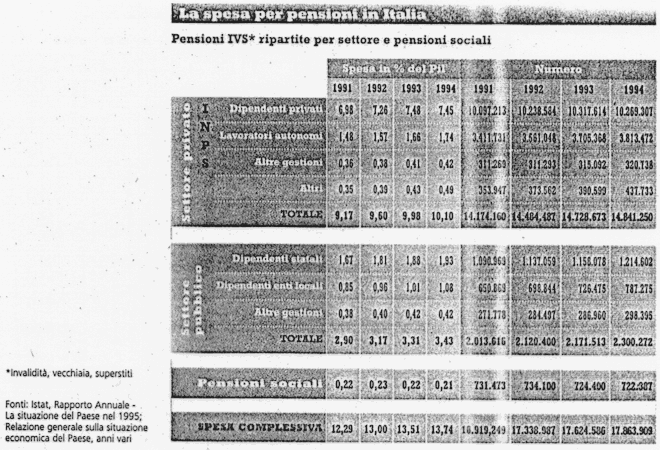
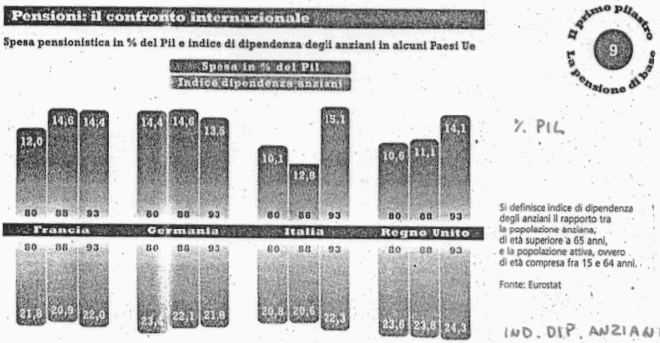
It is not very simple to analyze the mechanism of the social protection in
Italy. The management and the disbursement of the social-sanitary performances
have the shape of a fragmentary and complex structure, articulated in the
different competences entrusted to the State, to the Regions and to the Local
corporate bodies. ( Provinces, municipalities, sanitary firms) The absence of a
national law in the field of the assistance and the different displacements of
services and fit structures on the national territory causes big unbalances and
many uneasiness for the consumers,so that their rights are not always protected
and respected.
This is true especially for the small villages, damagedby the
absence or the lack of services and structures of quality and therefore forced
to exoduses to the bigger cities and also damaged by the thin budgets that don't
allow to face the different demands of the people and to propose initiatives for
social-sanitary interventions.
In relationship to the assert of the
social-safety concept, intended to protect the health and the psycho-phisical
comfort of all the citizens, a rational system that gives space to the different
and strong potentiality still doesn't exist.
This limit in the
rationalization of the social-sanitary services is still more evident if you
think of the complex normative picture that guides the social protection and of
the several laws and decrees that regulate functions and competences of the
Local corporate bodies. The tools, economic and/ or technical means, structures
and resources which all the citizens can (and have to use) in case of necessity
are therefore inserted in a very elaborated architecture.
Though ruled by
national and regional laws and by its own norms, the Local corporate bodies have
actually to decide how and how much to invest in the social services: many
interventions and initiatives( in favor of the elderly and disabled people and
of the social outcasts) also in respect of the competences and of the
legislative obligations are therefore entrusted to the evaluation and to the
sensibility of the local Administrations. The effects of this structural
formulation are easily deducible.
The worrisome datum, therefore, in Italy, is not only represented by the
dimension of the public expenses but by its unbalanced distribution, which is
oriented only in a small part towards the sector of the welfare (unemployment,
support to needy families) while the most part of it is absorbedby the pension
system, that also requires reforms.
To obviate these structural lacks and to
optimize the potentialities that the State in economic, professional and human
resources has to express, the Italian Government in these last months made
reforms of the Social State able to satisfy the more and more complex demands of
the actual society; - to prevent many of the uneasines of the juvenile world;-
to create a net of services to support also the smaller communities; -to avoid
wastes and overlaps in favor of a correct rationalization of the public services
and of the expenses to them connected.
All for the respect and the
protection of the human dignity and of the rights of the citizens to health and
to assistance.
To offer a general and simplified vision of the social structure, we will deal with some important aspects of the complex normative picture that goes under the name of social legislation. The numerous and heterogeneous norms among them which were passed in different times and which are still in force, even if some of them are not very topical cannot be easily arranged in an organic and defenite system. However you can define the object of the social legislation in the two important parts: the Assistance and the Previdenza.
Social Security concerns the situation during the work: it guarantees, in case of determined harmfull events (illness, invalidity, old age, unintentional unemployment), specific preformances, in final it guarantees protection to the subordinate workers in case of necessity. It is a form of social insurance, obligatory for all the dependent workers . It started at 1898 when the bad sanitary conditions , the exploitation of the weaker workers, the development of professional and other illness made necessary the protective intevention of the State. It results to be the most onerous employee benefit plan of all Europe. The biggest institute that manages the social foresight is the INPS.
Welfare; it is the part of the social legislation that, in case of
necessity, disburses- through the institution of public services- performances
of sanitary, moral, economic and rihabilitated type, to all the citizens,
independently from harmful events.
The State, for any situations of need not
appraisable beforehand, could not apply systems of prevention and has to trust
the relief forms. In practice, the State completes the social foresight in
those sectors and for those people that, not covered from other type of
insurance, are exposed to a state of necessity.
In practice the State has to
guarantee to all a free and dignified existence, the State has to protect the
health of all and has to remove economic and social obstacles (...) that prevent
the development of the person. The Welfare is a right sanctioned by the
Constitution. (art. 38)
From the 1977 a law by decree has delegated to the
Local bodies the organization and the disbursement of numerous services of
assistance, according criterions from Regional laws.
In the proposed picture
you can find synthesized some of the different functions and competences of the
public territorial body.
Active subjects of the social legislation
National organs
National Counsel of the Economy and of the
Labour (CNEL)
Ministry of Labour and of the Social Foresight
National Local Organs
Ispectorate of Labour
Office of the
Labour and of the Maximum employment
Other Organs of the Office of Labour
(center of emigration)
Prefect
Other offices
Public corporate body
Territorial; regions, provinces,
municipalities
Private subjects
Syndical organizations
International
organizations: org. intern. of the Labour (O.I.L.)
Institutions of Social Insurance
In Italy, the two biggest
institutions of foresight that provide for the guardianship of the workers and
that manage different forms of social insurances are; I.N.P.S. and I.N.A.I.L.
The I.N.P.S. ; National Institute for the Social Security is the biggest
among the institutes that pays the pensions and that take care of the compulsary
social insurances (old age, unemployment, illness) These social insurances are
needed for the protection of the worker who by carrying out his job, is subject
to a series of risks that his salary could not support, the social insurances
help, above all economically, to obviate to these harmful events.
The social
insurances disburse performances using financial means deriving from the payment
of contributions. Contributions payed by the worker each month until the end of
his work-contract. A small amount comes from the State.
The obligatory
payment of the contributions varies on the basis of to the activity, sector
(industry, commerce, craftsmanship) and qualification of the employee (worker,
manager, ecc). The situation of the autonomous workers and professionists is
completely different; their contributions are calculated, in percentage, on
their enterprise- income. (Irpef) Now they are trying to extend the guardianship
of the I.N.P.S. also to some autonomous workers. In particular the I.N.P.S.
manages;
| The I.N.A.I.L.: | National Institute for the Insurance against accidents on the Work. This Institute manages cases of accidents on the work and professional illness. The insurance has been made obligatory to all the workers and started in 1898. It is a corporate body subject to the vigilance of the Office for Work and partly also to the vigilance of the Office of Health. |
| There are some small institutes limited to some categories of workers: | |
| E.N.P.A.S.: | Nat. corporate body for the security and assistance for the workers in the public sector. |
| E.N.P.A.L.S. : | This institute involves the workers of the entertainment sector. |
| I.N.P.D.A.I.S.: | This institute guarantees for the executives of industrial firms. |
The protection of the Health
Since 1978, when the healthcare reform was passed, the protection of the
health was entrusted to the Sanitary National Service (S.S.N.)
"Such
reform represents one of the most important social-political facts of the last
times and an important element for the development of the employee benefit plan.
It represents a more organic and rational system of assistance and social
safety."
The guardianship of prevention against the illness and the
sanitary assistance has been widen thanks to this reform to all the citizens and
is disciplined with the direct intervention of the State. The public expenses in
sanitary subject are considerable and this doesn't mean that you can speak of a
good investment in the protection of the health. These expenses are due to an
incorrect managerial management, to not rational cuts, to overlaps of
competences and structures, see the building of many hospitals or similar
structures which are still incomplete or not used fully.
The Healthiness in
Italy represents a big problem, with negative consequences for the consumers as
far as the disbursement of services and assistance is concerned, but also with
reference to the the numerous taxes to pay which don't correspond to the
preformances. Sometimes the highest levels for quality and quantity are reached
in the bigger cities.
S.S.N. National Sanitary Service
This service involves the State, the Regions, the Provinces, the Consortium
of town councils in mountain areas, the Communes in the three stages of the
protection of the health; prevention, care, rehabilitation.
The healthcare
reform has entrusted to the Regions assignments connected to the environment,
the work, and the planning of the sanitary regional program.
The S.S.N. is
active in the field of caring; generic assistance, pediatrician assistance,
other specialistic assistance (services also inside the local sanitary unity);
hospital assistance (public hospitals and regional institutes ); pharmaceutical
assistance (medicines supply)
Summing up in sanitary subject the tasks are divided as follows;
U.S.L.
(sanitary local unity) for generic and specilistic preformances, hospitals;
I.N.P.S.
for the collection and the payment of contributions of maternity and of
illness.
I.N.A.I.L. for the accidents on the work and for professional
illness.
Considerations; "Quite this miscellany of competences (and relative
expenses) between the sector of prevention and relief in the protection of the
citizens hinders the rationalization and the full realization of the social
system in his complex:
while the Health exhausts practically all his funds
in the fullfilment of the function of taking care of the illness for what about
the other voices like the invalidity, the maternity, the unemployment, the
support to the family it is difficult to find the money to cover these expenses
because the exchanges between the sector of the prevention and the relief
represents the complexity of the system of social protection" which doesn't
know how to create a correct equilibrium in favor of the citizens.
The
assistance also is strongly damaged from the financial point of view because the
funds go always in favor of the pensions that in his actual organization
presents serious problems.
The articulation of the Italian State in Regions, Provinces and Communes in full respect of their autonomy but acting for the good of the State, creates sometimes, difficulty in giving adequate answers to the different demands of the cosumers. It is necessary therefore to carry out territorial politics which in line with the volunteeer and of the non profit associations - realize proper networks to support the individual and the family in difficulty, on the whole territory, without discriminations. Only in that way it will be possible to realize the fullfilment of the whole system of social security.
• • Copyright © IWB
e.V. 1996-2000 • Webmaster:
ohlendorf@eduvinet.de
• •
• • 800 x 600 recommended
• •